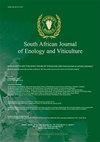Effect of Calcium Carbonate Residues from Cement Industries on the Phenolic Composition and Yield of Shiraz Grapes
IF 1.1
4区 农林科学
Q4 FOOD SCIENCE & TECHNOLOGY
引用次数: 2
Abstract
Phenolic compounds are secondary metabolites synthesised in response to biotic or abiotic stress in plants. This stress-induced increase in phenolic compound concentrations is generally activated by internal levels of abscisic acid (ABA). The exogenous application of ABA or calcium chloride on grapevines is also known to increase grape yield and alter the phenolic composition of grapes. Residues of cement industries such as calcium carbonates (CaCO3) are a safe environmental source of calcium that could be used to induce the synthesis of phenolic compounds and act as a yield promoter in grapes and other crops. Consequently, the objective of this study was to evaluate the effect of cement industries’ CaCO3 residues (CaCO3R) on the yield and concentration of phenolic compounds in Shiraz grapes. Thirteen phenolic compounds were identified and quantified by HPLC-DAD. Malvidin-3-O-glucoside was the major anthocyanin found in Shiraz grapes, and its concentration increased by more than 200% in CaCO3R-treated vines. Similarly, the concentration of cinnamic acid, the main precursor of phenolic compounds, increased by more than 900% in grapes treated with CaCO3 residues at harvest time. Finally, catechin, epicatechin and procyanidin B1 and B2 increased significantly at harvest time in CaCO3R-treated grapes relative to the controls. In general, it was found that foliar application of CaCO3 residues from the cement industry at veraison induced an increase in yield, and in the concentration and composition of phenolic compounds in grapes.水泥工业碳酸钙废渣对设拉子葡萄酚类成分及产量的影响
酚类化合物是植物在生物或非生物胁迫下合成的次生代谢物。这种应激诱导的酚类化合物浓度的增加通常是由体内脱落酸(ABA)水平激活的。在葡萄藤上外源施用ABA或氯化钙也可以提高葡萄产量并改变葡萄的酚类成分。水泥工业的残留物,如碳酸钙(CaCO3)是一种安全的环境钙来源,可用于诱导酚类化合物的合成,并作为葡萄和其他作物的产量促进剂。因此,本研究的目的是评估水泥工业的CaCO3残留物(CaCO3R)对设拉子葡萄中酚类化合物的产量和浓度的影响。用HPLC-DAD对13种酚类化合物进行了鉴定和定量。Malvidin-3-O-glucoside是设拉子葡萄中发现的主要花青素,其浓度在caco3r处理的葡萄中增加了200%以上。同样,酚类化合物的主要前体肉桂酸的浓度在收获时用CaCO3残留物处理的葡萄中增加了900%以上。最后,与对照相比,caco3r处理葡萄的儿茶素、表儿茶素和原花青素B1和B2在收获时显著增加。总的来说,研究发现,在葡萄叶片上施用水泥工业的CaCO3残留物可以提高葡萄的产量,增加葡萄中酚类化合物的浓度和组成。
本文章由计算机程序翻译,如有差异,请以英文原文为准。
求助全文
约1分钟内获得全文
求助全文
来源期刊
CiteScore
2.50
自引率
7.70%
发文量
1
审稿时长
>36 weeks
期刊介绍:
The South African Journal of Enology and Viticulture (SAJEV) publishes full-length original Research Papers, Research Notes and Review Papers on all subjects related to enology and viticulture. The SAJEV does not accept articles published in, or submitted to, other journals.

 求助内容:
求助内容: 应助结果提醒方式:
应助结果提醒方式:


